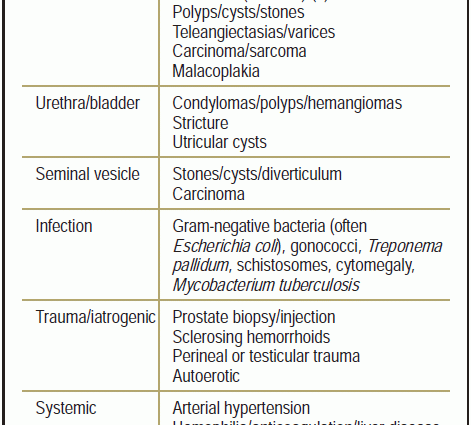Contents
Hematospermia is the presence of erythrocytes in the ejaculate. This ailment always requires consultation with a urologist, because it may be a symptom of a more serious disease, and its symptom in the form of blood in the semen may also occur with other symptoms, e.g. pollakiuria or perineal discomfort. The most common cause of hematospermia is prostate disease.
Hematospermia – the definition of the disease
Hematospermia is blood in sperm and is usually the result of some kind of inflammation, trauma, or irritation. This ailment should always be consulted with a urologist. In addition, the symptom in the form of blood in the sperm often accompanied by other symptoms, such as pollakiuria, a weak urine stream, or a sudden urge to urinate. In most patients, the blood in the semen disappears on its own, and finding a specific cause of the disease is a real challenge for doctors. In about 60% of cases, it is easy to find the cause of hematospermia, and its occurrence in men under 40 does not indicate a more serious disorder.
Hematospermia – causes
The most common cause of hematospermia is prostate disease. However, there are a number of other factors that can cause the disease, as semen ejaculates a long way from the seminal tubules to the urethra. During it, blood is collected from a certain place. Therefore, other causes of the disease include:
- past injuries in the perineum area,
- gonorrhea,
- herpes
- prostate biopsy or ultrasound,
- cancer – testicles, prostate (rarely), epididymis,
- benign prostatic hypertrophy,
- malignant hypertension,
- infections of the testicles, epididymis and urethra, inflammatory changes,
- genital warts,
- urogenital tuberculosis,
- liver disorders,
- cysts,
- pathology in the area of ejaculation lines,
- overdosing of anticoagulants,
- general coagulation disorders.
Types of hematospermia
Stands out transient hematospermia – resulting from the extravasation of a small amount of blood in the prostate gland, and constant – in the course of prostate angiomas and neoplasms.
Hematospermia – diagnosis
In most cases, hematospermia is of unknown origin and resolves on its own. In the diagnosis of the disease, it is important to determine the age of the patient and the frequency with which it appears in the blood in the semen. The basis of diagnostic tests is to check whether the patient does not suffer from a cancer of the genitourinary system or other inflammation. In addition, the doctor conducts a medical interview with the patient, including information about sexually transmitted diseases, because these diseases can be cause of hematospermia in menwho had accidental sexual intercourse with an unknown partner. Other tests to help diagnose the disease include:
- laboratory tests – a general urine test, semen culture and PSA concentration are performed. A general urine test can determine if the patient has developed a urinary tract infection or the presence of red blood cells in the urine. Semen culture (positive) may indicate an inflammatory cause of hematospermia. However, a high level PSA in a patient with hematospermia it may be prostate cancer or inflammation;
- physical examination – a patient presenting with a symptom of hematospermia to a doctor undergoes an external examination of the genital organs and an examination performed by palpation through the anus. These tests are performed to identify possible abnormalities in the prostate area;
- imaging – in high-risk patients, imaging tests are performed in the form of transrectal ultrasound – TRUS and megnetic resonance – MRI.
How to treat hematospermia?
Initially, the cause of hematospermia should be determined in order to receive appropriate treatment. The most important task of a urologist is to exclude cancer of the bladder and prostate gland in the patient, which are the most important element of diagnostics. In young patients excluded from these diseases, no special treatment is needed, as in most patients the blood in the semen passes spontaneously. In turn, in patients over 40 years of age with risk factors associated with hematospermia, it is necessary to extend urological diagnostics.
Treatment will be different in each case. If the blood in the sperm is due to an injury – use cold compresses and rest so that the patient can regenerate. If an infection is the cause of blood in the semen, the urologist will prescribe antibiotics to be taken at home. On the other hand, if hematospermia results from obstruction of the urogenital tract – surgery is performed. Cancer or its suspicion requires consultation with an oncologist who will decide on further treatment.
Lit .: [1] Braun-Falco O., Plewig G., Wolff HH, Burgdorf WHC: Dermatology, eds. half. Gliński W., Wolska H., Wydawnictwo Czelej, Lublin 2002. [2] Semczuk M., Kurpisz M .: Andrology. Ed. Bow. PZWL, Warsaw 2006.
Source: A. Kaszuba, Z. Adamski: “Lexicon of dermatology”; XNUMXst edition, Czelej Publishing House










